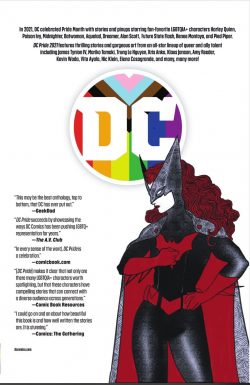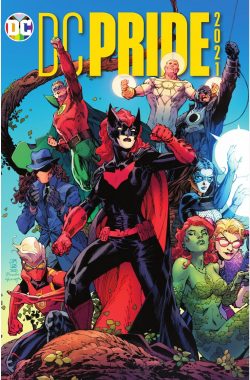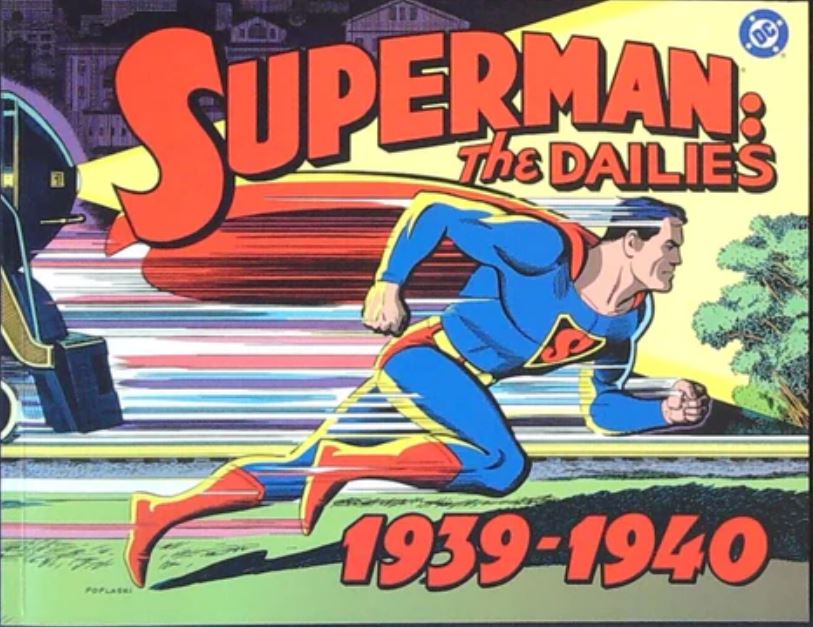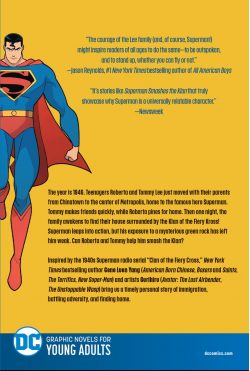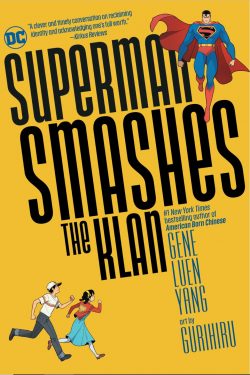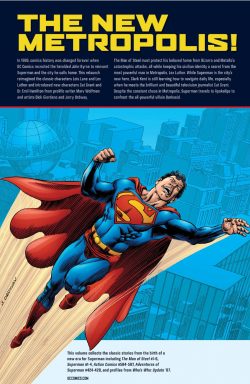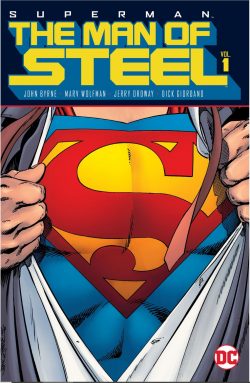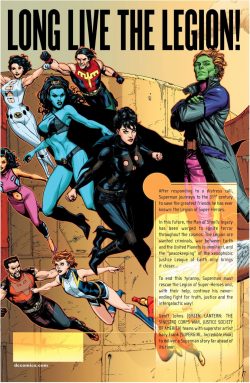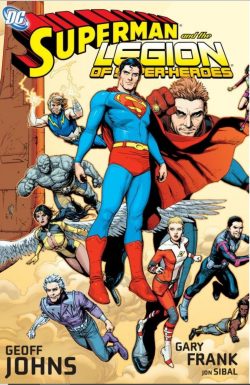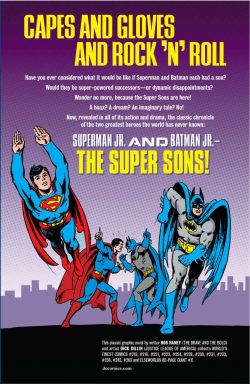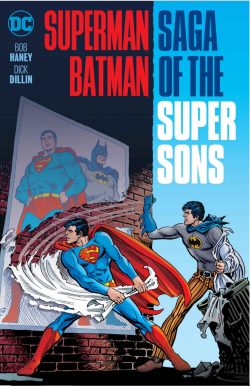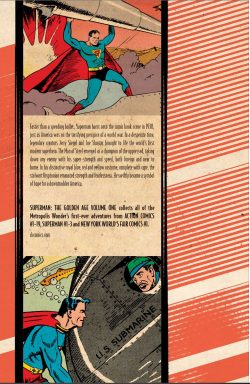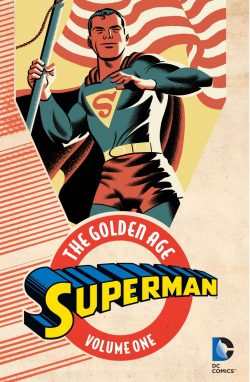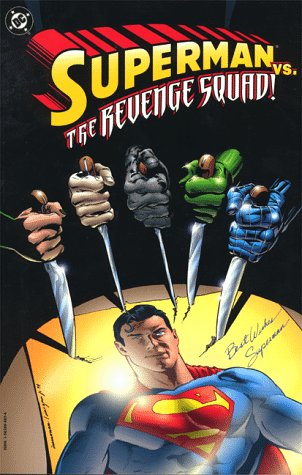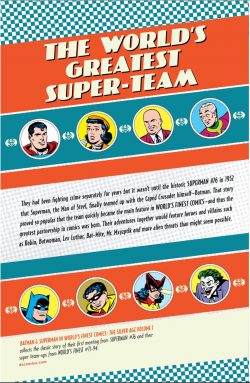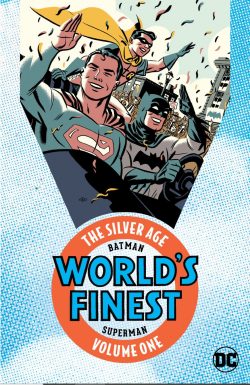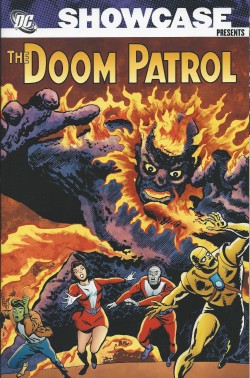
By Arnold Drake, Bruno Premiani, Bob Brown & various (DC Comics)
ISBN: 978-1-85768-077-8 (TPB)
In 1963 DC/National Comics converted a venerable anthology-mystery title – My Greatest Adventure – into a fringe superhero team-book with #80, introducing a startling squad of champions with their thematic roots still firmly planted in the B-movie monster films of the era which had for so long informed the tone and timbre of the parent title.
That aesthetic subtly shaped the progression of the strip – which took control of the title within months, prompting a title change to The Doom Patrol with #86 – and throughout a 6-year run made the series one of the most eerily innovative and incessantly hip reads of that generation. Happy 60th Anniversary, you “Fabulous Freaks”!
No traditional team of masked adventurers, the cast comprised a robot, a mummy and a 50-foot woman in a mini-skirt, united with and guided by a brusque, domineering, crippled mad scientist, all equally determined to prove themselves by fighting injustice their way…
Two relatively recent compilations are still awaiting a third and final edition to complete the reprint run, and this monochrome tome from 2010 might have to do for some time yet.
Should you be afflicted with the curse of a completist nature, Doom Patrol: The Silver Age volume 1 spans June 1963 to May 1965, re-presenting in full colour My Greatest Adventure #80-85 and Doom Patrol #86-95, whilst Doom Patrol: The Silver Age volume 2 covers June 1965-November 1966 via Doom Patrol #96-107, The Brave and the Bold #65 and Challengers of the Unknown #48. They’re both available digitally, but should you want a comprehensive read-through, that’s going to take a little more effort than we spoiled 21st Centurians are used to…
Spanning March 1966 to their radically bold demise in the September/October 1968 final issue, this quirky monochrome compilation collects their last exploits as seen in Doom Patrol #102 to 121: a landmark run that truly deserves better dissemination…
These creepy Costumed Dramas were especially enhanced by the superb skills of Italian artist Giordano Bruno Premiani, whose comfortably detailed, subtly representational illustration style made even the strangest situation frighteningly authentic and grimly believable.
As such, he was the perfect vehicle to squeeze every nuance of comedy and pathos from the captivatingly involved and grimly light-hearted scripts by Arnold Drake who always proffered a tantalising believably world for the outcast heroes to strive in.
Those damaged champions comprised competitive car racer Cliff Steele, but only after he’d had “died” in a horrific crash, with his undamaged brain transplanted into a fantastic mechanical body – without his knowledge or permission…
Test pilot Larry Trainor was trapped in an experimental stratospheric plane and become permanently radioactive, with the dubious benefit of gaining a semi-sentient energy avatar which could escape his body to perform incredible stunts …for up to a minute at a time. To pass safely amongst men, Trainor had to be perpetually wrapped in radiation-proof bandages.
Former movie star Rita Farr was exposed to mysterious gases on location. These gave her the unpredictable, initially uncontrolled ability to shrink or grow – in part or wholly – to incredible sizes.
The outcasts were brought together by brilliant, enigmatic Renaissance Man Niles Caulder who, as The Chief, sought to mould the solitary misfits into a force for good. The wheelchair-bound savant directed the trio of solitary strangers in many terrifying missions as they slowly grew into a uniquely bonded family…
Here – now firmly established in the heroic pantheon – The Doom Patrol join fellow outsiders The Challengers of the Unknown in #102’s ‘8 Against Eternity!’: battling murderous shape-shifter Multi-Man and his robotic allies as they seek to unleash a horde of zombies from a lost world upon modern humanity
Meanwhile, super-rich Steve Dayton – who had created a psycho-kinetic superhero persona Mento solely to woo and wed Rita, met outrageous, obnoxious Gar Logan. It was disgust at first sight, but neither the ruthless, driven billionaire authority figure nor wildly rebellious Beast Boy realised how their lives would soon entwine…
Whilst a toddler in Africa, Logan had contracted a rare disease. Although his scientist parents’ experimental cure beat the contagion before they died, it left him the colour of cabbage and able to change shape at will. A protracted storyline commenced in #100 wherein the secretive, chameleonic kid revealed how he was now an abused orphan being swindled out of his inheritance by his unscrupulous guardian Nicholas Galtry. The greedy, conniving accountant had even leased his emerald-hued charge to rogue scientists…
Rita especially had empathised with Gar’s plight and resolved to free him from Galtry whatever the cost…
DP #103 held two tales, beginning with a tragedy ensuing after Professor Randolph Ormsby sought the team’s aid for a space shot. When the doddery savant mutates into flaming monster ‘The Meteor Man’ it takes the entire patrol plus Beast Boy and Mento to save the day.
‘No Home for a Robot’, continues unpacking the Mechanical Man’s early days following Caulder’s implantation of Cliff’s brain into an artificial body. The shock had seemingly driven the patient crazy as Steele went on a city-wide rampage, hunted and hounded by the police. Here, the ferrous fugitive finds brief respite with his brother Randy, before realising that trouble would trail him anywhere…
DP #104 astounded everyone as Rita abruptly stopped refusing loathsome Steve to become ‘The Bride of the Doom Patrol!’ However, her star-stuffed wedding day is almost ruined when alien arch-foe Garguax and The Brotherhood of Evil crash the party to murder the groom. So unhappy are Cliff and Larry with Rita’s “betrayal” that they almost let them…
Even whilst indulging her new bride status in #105, Rita can’t abandon the team and joins them in tackling old elemental enemy Mr. 103 during a ‘Honeymoon of Terror!’ before back-up yarn ‘The Robot-Maker Must Die’ concludes Cliff Steele’s origin as the renegade attempts to kill the mystery surgeon who had imprisoned him in a metal hell… finally giving Caulder a chance to fix a long-term malfunction in Steele’s systems…
‘Blood Brothers!’ in #106 introduces domestic disharmony as Rita steadfastly refuses to be a good trophy wife: resuming the hunt for Mr. 103 with the rest of the DP. Her separate lives continue to intersect, however, when Galtry hires that elemental assassin to wipe Gar and his freakish allies off the books…
The back-up section shifts focus onto ‘The Private World of Negative Man’: recapitulating Larry Trainor’s doomed flight and the radioactive close encounter that turned him into a walking mummy. However, even after being allowed to walk amongst men again, the gregarious pilot finds himself utterly isolated and alone…
Doom Patrol #107 began an epic story-arc concerning ‘The War over Beast Boy!’ as Rita and Steve open legal proceedings to get Gar and his money away from Galtry. The embezzler responds by commencing a criminal campaign to beggar Dayton which inadvertently aligns him with the team’s greatest foes. Already distracted by the depredations of marauding automaton Ultimax, the hard-pressed heroes swiftly fall to the murderous mechanoid as Rita is banished to a barbaric sub-atomic universe…
The secret history of Negative Man resumes with ‘The Race Against Dr. Death!’ when fellow self-imposed outcast Dr. Drew draws the pilot into a scheme to destroy the human species which had cruelly excluded them both, before Larry’s ebony energy being demonstrates the incredible power it possesses by saving the world from fiery doom.
In #108, ‘Kid Disaster!’ sees Mento diminished and despatched to rescue Rita whilst Galtry’s allies reveal their true nature before ambushing and killing the entire team…
…Almost.
Despite only Caulder and Beast Boy remaining, our exceedingly odd couple nevertheless pull off a major medical miracle: reviving the heroes in time to endure the incredible attack of alien colossus ‘Mandred the Executioner!’ whilst Larry’s ‘Flight into Fear’ at the comic’s rear proves that Drew hasn’t finished with the itinerant Negative Man yet…
DP #110 wonderfully wraps up the Beast Boy saga as Galtry, Mandred and the Brotherhood marshal one last futile attack before the ‘Trial by Terror!’ finally finds Logan legally adopted by newlyweds Mr. and Mrs. Dayton. Sadly, it’s a prelude to a titanic extraterrestrial invasion in #111, which heralds the arrival of ‘Zarox-13, Emperor of the Cosmos!’
The awesome overlord and his vanguard Garguax make short work of the Fabulous Freaks and, with all Earth imperilled, an unbelievable alliance forms, but not before ‘Neg Man’s Last Road!’ ends Trainor’s tale as the alienated aviator again battles Dr. Death, before joining a band of fellow outcasts in a bold new team venture…
Unbelievably, the uneasy alliance of the DP with The Brain, Monsieur Mallah and Madame Rouge as ‘Brothers in Blood!’ in #112 results in no betrayals and the last-minute defeat of the invincible aliens.
Moreover, although no rivalries were reconciled, a hint of romance does develop between two of the sworn foes, whilst at the back, untold tales of Beast Boy begin as ‘Waif of the Wilderness’ introduces millionaire doctors Mark and Marie Logan whose passion for charity took them to deepest Africa and into the sights of native witch-man Mobu who saw his powerbase crumbling…
When their toddler Gar contracts dread disease Sakutia, the parents’ radical treatment saves their child and grants him metamorphic abilities, but as they subsequently lose their lives in a river accident, the baby boy cannot understand their plight and blithely watches them die.
Orphaned and lonely, he inadvertently saves the life of a local chief with his animal antics and is adopted, …making of Mobu an implacable, impatient enemy…
Doom Patrol #113 pits the team against a malevolent mechanoid one-man army in ‘Who Dares to Challenge the Arsenal?’ but the real drama manifests in a subplot showing Caulder seeking to seduce schizophrenic Rouge away from the lure of wickedness and malign influence of the Brotherhood of Evil.
The issue includes another Beast Boy short as ‘The Diamonds of Destiny!’ finds two thieves kidnapping the amazing boy, just as concerned executor Nicholas Galtry takes ship for the Dark Continent to find the heir to his deceased employer’s millions…
DP #114 opens with the team aiding Soviet asylum seeker Anton Koravyk and becoming embroiled in a time-twisting fight against incredible caveman ‘Kor – the Conqueror!’ whilst Beast Boy segment ‘The Kid who was King of Crooks!’ sees toddler Gar turned into a thief in Johannesburg… until his Fagin-ish abductors have a fatal falling out…
The next issue debuts ‘The Mutant Master!’: pitting the team against three hideous, incomprehensibly powerful atomic atrocities resolved to eradicate the world which had cruelly treated them. Things might have fared better had not the Chief neglected his comrades in his obsessive – and at last successful – pursuit of Madame Rouge…
Also included is ‘General Beast Boy – of the Ape Brigade!’, wherein a Nazi war criminal is accidentally foiled by lost wanderer Gar. The madman’s loss is Galtry’s gain, however, as his search ends with the crook “rescuing” Logan and taking him back to safe, secure America…
The mutant maelstrom concludes in #116 as ‘Two to Get Ready… and Three to Die!’ features Caulder saving Earth from mutant-triggered obliteration to reap his reward in a passionate fling with the cured – but still fragile – Rouge.
The wheelchair wonder seizes centre stage in #117 as his neglect drives the team away, leaving him vulnerable to attack from a mystery man with a big grudge in ‘The Black Vulture!’, before a reunited squad deals with grotesque madman ‘Videx, Monarch of Light!’ even as the Brain challenges Caulder to return his stolen chattel Rouge. Nobody thought to ask her what she wanted, though, and that’s a fatal oversight…
Tastes were changing in the turbulent late 1960s and the series was in trouble. Superheroes were about to plunge into mass decline, and the creators addressed the problem head-on in #119: embracing psychedelic counter culture in a clever tale of supernal power, brainwashing and behaviour modification leaving the DP cowering ‘In the Shadow of the Great Guru!’…
An issue later they faced a furious Luddite’s ‘Rage of the Wrecker!’ when a crazed scientist declares war on technology – including the assorted bodies keeping Cliff alive…
The then-unthinkable occurred next and the series spectacularly, abruptly ended with what we all believed at the time to be ‘The Death of the Doom Patrol!’…
Faced with cancellation, Editor Murray Boltinoff and creators Drake & Premiani wrapped up all the long-running plot threads as spurned Madame Rouge goes off the deep end and declares war on both the Brain and Caulder’s “children”…
Blowing up the Brotherhood, she attacks the city until the DP remove themselves to an isolated island fortress. Even there they are not safe and her forces ambush them…
Captured and facing death, Rouge offers mercy if they abandon their principles and allow her to destroy a village of 14 complete strangers in their stead…
At a time when comics came and went with no fanfare and cancelled titles seldom provided any closure, the sacrifice and death of the Doom Patrol was a shocking event for us youngsters. We wouldn’t see anything like it again for decades – and never again with such style and impact…
With the edge of time and experience on my side, it’s obvious just how incredibly mature Drake & Premiani’s take on superheroes was, and these superbly engaging, frenetically fun and breathtakingly beautiful stories rightfully rank amongst the very best Fights ‘n’ Tights tales ever told.
Even the mercilessly exploitative many returns of the team since can’t diminish that incredible impact, and no fan of the genre or comic dramas in general should consider their superhero education complete until they’ve seen these classics. Let’s hope DC wise up quickly and release that final volume soon…
© 1966, 1967, 1968, 2010 DC Comics, Inc. All Rights Reserved.
